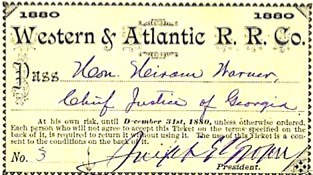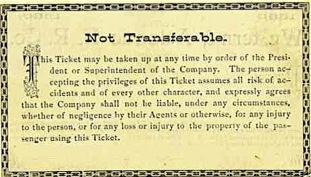




Western & Atlantic: 'Crookedest Road Under the Sun
by James G. Bogle
for Southeastern Railway Museum
The Western & Atlantic Railroad of the State of Georgia was created by an act of the General Assembly of Georgia on December 21, 1836. Since it was to cross the state line into Tennessee and connect with the Tennessee River near Ross' Landing, companion legislation was passed by the Tennessee General Assembly on January 24, 1838. These legislative acts provided for a railroad to be surveyed and constructed from a point near present-day Chattanooga on the Tennessee River, to an eligible point on the southeastern bank of the Chattahoochee River in Georgia.
The survey was made under the direction of Lt. Colonel Stephen Harriman Long, U.S. Army. Construction began around the end of November 1839 and the last rails were laid in the Spring of 1850. The total cost of building the W&A RR was $4,087,925 and it was paid for by the people of Georgia.
When the southern end of the W&A RR was located at a point southeast of the Chattahoochee River to be known as Terminus, later Marthasville, and Atlanta, the Macon & Western Railroad and the Georgia Railroad were extended to that point. Another important link was the Atlanta & LaGrange Railroad, begun in 1849, which later formed the line from Atlanta to West Point and on to Montgomery, via the Western Railway of Alabama, better known as the West Point Route.
With so much railroad building going on in Georgia, the state of Tennessee recognized the need for land transportation and in 1845 authorized the construction of the Nashville & Chattanooga Railroad connecting the named cities. Construction of the East Tennessee & Georgia Railroad began soon after to provide a line connecting Knoxville to the south with the W&A RR at Dalton, Georgia. Later a branch line was built from Cleveland, Tennessee, to Chattanooga using a tunnel bored through the north end of Missionary Ridge. Another line was built east of Memphis, the Memphis & Charleston Railroad which connected with the N&C RR at Stevenson, Alabama, and used the latters tracks to enter Chattanooga.
The W&A RR was the connecting link in a well devised system of railroads that made Georgia the Keystone State of the South and the future City of Atlanta, the Gateway City. The route today remains essentially as surveyed by Colonel Long and his men in the 1830s. The W&A RR is a very crooked one with total curvatures exceeding 10,000 degrees which means that in a distance of 138 miles, the road makes about 28 complete circles. Superintendant John W. Lewis, in his annual report of September, 30, 1860, referred to the W&A RR as the "crookedest road under the sun."
Colonel Long did lay out a line that was free of heavy grades. The ruling grade is less than one percent which is remarkable considering the topography between Atlanta and Chattanooga. Colonel Long found a way to leave Chattanooga without having to tunnel under Missionary Ridge, but as he came south through the ridge and valley section of northwest Georgia it was necessary to tunnel through Chetoogeta Mountain. This tunnel was the final obstacle to completion of the W&A RR and the headings were driven through on October 31, 1849. On May 9, 1850, the rails were finished and the first train ran over the entire line. This tunnel is 1,447 feet in length and extends in an east-west direction though the W&A runs in a general north-south direction.
The road bed of the W&A, as initially constructed, would bear little resemblance to the line of today. Untreated logs for ties, no ballast with strap iron rails with holes for spikes in the bar. Later, a flange rail was used, then came the "U" rail and finally the "T" rail. By 1861 when the Civil War began, the W&A had the early form of "T" rail on the first 50 miles north of Atlanta and the balance was "U" rail with some flange bar rail on the northern end. Motive power was of the American type, 4-4-0, and we have two excellent examples in our area today--the General and the Texas.
The W&A was well used in the Civil War and was essentially the route of The Atlanta Campaign in 1864. After the war, General William T. Sherman, commander of the Federal forces wrote: "The W&A RR of Georgia should be the pride of every true American because by reason of its existence the Union was saved. Every foot of it should be sacred ground, because it was once moistened with patriotic blood. Over a hundred miles of it was fought in a continuous battle of 120 days, during which, night and day, were heard the continuous boom of cannon and the sharp crack of the rifle."
The W&A went through some bad times during the Reconstruction Period following the Civil War. On December 12, 1870, State operation of the line ceased and it was leased to the Western & Atlantic Railroad Company formed by ex-Governor Joseph E. Brown. This lease was good for the line and lasted until 1890 when the Nashville, Chattanooga & St. Louis Railway obtained lease of the railroad. Then in 1957, when the Louisville &Nashville RR merged the NC & StL into their system, the L&N secured the lease. So operation of the W&A continued through successor companies until the formation of CSX Transportation who now operates this very busy railroad from Atlanta to Chattanooga.

Buildings of the W&A RR
at Atlanta Ga. 1864
These were all destroyed a few days later
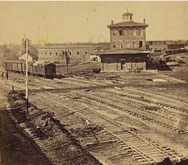
Western & Atlantic Railroad
This 137-mile line between Atlanta and Chattanooga was built in 1841–50 by the State of Georgia at a cost of almost five million dollars. Surveys for the line began in 1837, and the first train ran from Marthasville (Atlanta) to Marietta on December 23, 1842. The locomotive had to be hauled by wagon from Madison, which was at the time the terminus of the Georgia Railroad. Regular service would not begin until 1845.
The Georgia Railroad reached Atlanta in September of 1845, followed by the Macon and Western the following year. In 1854, the Atlanta and West Point opened a fourth line into town, coming in from the southwest.
The W&A became a key link in the chain of Southern antebellum railroads connecting the Atlantic Ocean and the Mississippi River and was the foundation for Atlanta’s emergence as a rail center.
By the time of the Civil War, the W&A had 46 wood burning locomotives, two of which were to become participants in the “Great Locomotive Chase” of April 1862. It played a major role in the Atlanta Campaign and its loss to the South in 1864 was a serious blow to the Confederacy’s hopes of ultimate victory. Like many Southern railroads, the W&A suffered extensive damage during the war.
In 1870, the road and rolling stock were leased for 20 years to a corporation headed by former Governor Joseph E. Brown and made up primarily of the officers of the W&A's connecting roads.
In 1890, the W&A was leased to the Nashville, Chattanooga, and St. Louis Railway.
Owned by the state since its construction, the line is currently under a long-term lease to NC&St.L successor CSX Transportation.
This 137-mile line between Atlanta and Chattanooga was built in 1841–50 by the State of Georgia at a cost of almost five million dollars. Surveys for the line began in 1837, and the first train ran from Marthasville (Atlanta) to Marietta on December 23, 1842. The locomotive had to be hauled by wagon from Madison, which was at the time the terminus of the Georgia Railroad. Regular service would not begin until 1845.
The Georgia Railroad reached Atlanta in September of 1845, followed by the Macon and Western the following year. In 1854, the Atlanta and West Point opened a fourth line into town, coming in from the southwest.
The W&A became a key link in the chain of Southern antebellum railroads connecting the Atlantic Ocean and the Mississippi River and was the foundation for Atlanta’s emergence as a rail center.
By the time of the Civil War, the W&A had 46 wood burning locomotives, two of which were to become participants in the “Great Locomotive Chase” of April 1862. It played a major role in the Atlanta Campaign and its loss to the South in 1864 was a serious blow to the Confederacy’s hopes of ultimate victory. Like many Southern railroads, the W&A suffered extensive damage during the war.
In 1870, the road and rolling stock were leased for 20 years to a corporation headed by former Governor Joseph E. Brown and made up primarily of the officers of the W&A's connecting roads.
In 1890, the W&A was leased to the Nashville, Chattanooga, and St. Louis Railway.
Owned by the state since its construction, the line is currently under a long-term lease to NC&St.L successor CSX Transportation.
----------------------------------------------------------------------------------------------

The Georgia legislature recognized the importance of fostering railroad construction to open up the western portions of the state and granted charters to build three major lines in 1833: Augusta to Athens, Savannah to Macon and Macon to Forsyth. The legislature followed up by establishing the Western & Atlantic Railroad (W&A RR) in 1836 to connect the Chattahoochee River to the Tennessee River. They also provided for the extension of the railroads from Athens and Forsyth to the Western and Atlantic.
In 1837 surveyors for the three railroads selected a locale 7 miles southeast of the Chattahoochee River as a southern terminus for the railroads. A small settlement, aptly named Terminus, arose at this location. While work was progressing on the Western and Atlantic, Terminus grew, changing its name to Marthasville in 1843 and to Atlanta (in honor of the railroad) in 1845.
Lt. Col. Stephen H. Long surveyed and laid out the 108-mile route to the Tennessee border in 1837. Three potential routes from the Tennessee border were provided. He estimated the cost at 2.1 million dollars and provided a detailed plan for the first 25 miles. The Georgia legislature authorized the Georgia Railroad based on the plan. The Georgia legislature funded the railroad over the veto of Governor Gilmer using the federal funds from the sale of public lands and borrowing the remainder. Bids for the first 25 miles were issued in April 1838 and hiring started on March 2.
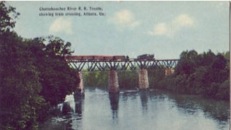
The lack of funds as a result of the national Panic of 1837 - 1842 delayed and finally halted construction. Construction began again as the economy improved. The first 22 miles from Marietta to Atlanta were completed in September 1845. The line was completed to Dalton in July 1847. Because of the difficulty in constructing the tunnel north of Dalton, at Tunnel Hill, the track on the other side of the proposed tunnel was started and completed to Chattanooga before the tunnel was completed. The tunnel opened on May 9, 1850 completing the W&A RR.
Even before the line was completed, the W&A RR was bringing in significant revenue into the Georgia treasury. In 1847 it contributed $125,000 to state revenue. By 1860 the W&A RR was contributing 50% of the state's revenue. When the Civil War began in 1861, Virginia, Georgia and Tennessee were 1st, 2nd and 3rd in miles of railroad track (1771, 1404, and 1197 miles). The Union forces chose to follow the railroads from Nashville to Chattanooga to Atlanta to allow easy supply to the advancing troops, as well as denying the Confederacy the use of the railroads for supplies and troop movement.
-----------------------------------
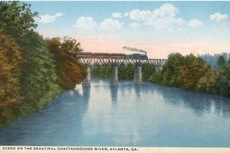
Atlanta Terminal 18??


RAILROAD YARDS, ATLANTA TERMINAL STATION
